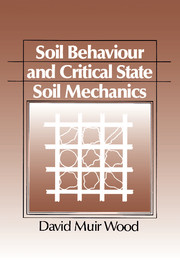Book contents
- Frontmatter
- Dedication
- Contents
- Preface
- Acknowledgements
- List of symbols
- 1 Introduction: models and soil mechanics
- 2 Elasticity
- 3 Plasticity and yielding
- 4 Elastic-plastic model for soil
- 5 A particular elastic—plastic model: Cam clay
- 6 Critical states
- 7 Strength of soils
- 8 Stress—dilatancy
- 9 Index properties
- 10 Stress paths and soil tests
- 11 Applications of elastic—plastic models
- 12 Beyond the simple models
- References
- Index
11 - Applications of elastic—plastic models
Published online by Cambridge University Press: 05 October 2014
- Frontmatter
- Dedication
- Contents
- Preface
- Acknowledgements
- List of symbols
- 1 Introduction: models and soil mechanics
- 2 Elasticity
- 3 Plasticity and yielding
- 4 Elastic-plastic model for soil
- 5 A particular elastic—plastic model: Cam clay
- 6 Critical states
- 7 Strength of soils
- 8 Stress—dilatancy
- 9 Index properties
- 10 Stress paths and soil tests
- 11 Applications of elastic—plastic models
- 12 Beyond the simple models
- References
- Index
Summary
Introduction
Some applications of elastic—plastic models to the evaluation or prediction of the behaviour of real geotechnical prototypes are now presented. The first application links back to the discussion of stress paths in the previous chapter: simple estimates of stress paths can be used to illustrate both the onset of plastic deformation in soil beneath a surface load and the influence that this plastic deformation has on the development of excess pore pressures and the settlement of foundations. This should be regarded as a pedagogic example to demonstrate the significance of elastic—plastic behaviour rather than as a recommended solution to a design problem. Once elastic—plastic descriptions of material non-linearity are introduced, it is rarely possible to avoid resort to computer-aided numerical analyses.
The following section summarises some more complete applications of elastic—plastic models in numerical analyses made using the finite element method. These examples have been chosen to illustrate the use of two different elastic—plastic models. Although it may appear that this book has placed undue emphasis on the Cam clay model, it is neither the only nor necessarily the best model which can be used for numerical predictions. There is an evident bias towards soft clay in these applications. The framework of volumetric hardening models developed in detail in Chapter 4 is particularly suited to the description of soft clays.
- Type
- Chapter
- Information
- Soil Behaviour and Critical State Soil Mechanics , pp. 354 - 413Publisher: Cambridge University PressPrint publication year: 1991



